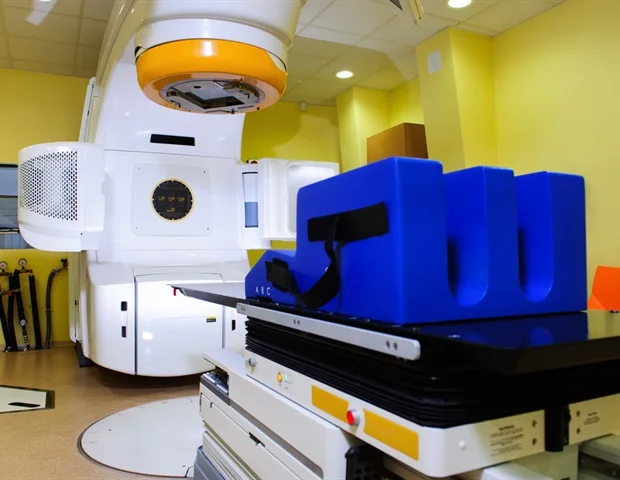Whole breast radiation and partial breast radiation following a lumpectomy yield similar cosmetic outcomes for women diagnosed with early stages of cancer who wish to preserve their breasts. Findings of the new analysis from a phase III clinical trial were presented at the 61st Annual Meeting of the American Society for Radiation Oncology (ASTRO).
Partial breast radiation is a good choice. That’s what I’m going to say to certain subsets of my patients.”
Julia White, MD, FASTRO, professor of radiation oncology, The Ohio State University Comprehensive Cancer Center and lead author
Women diagnosed with early stages of cancer (stage 2 or earlier) who undergo lumpectomies typically follow their surgery with radiation therapy to lower the risk of having the cancer return. Partial breast radiation can be an appealing treatment option, because the radiation is delivered over several days to a smaller area around the surgical site instead of 3 to 4 weeks to the entire breast.
Previously published results from this phase III trial, NRG Oncology/NSABP B39-RTOG 0413, found partial breast radiation to be only slightly less effective than whole breast radiation at reducing the risk of cancer recurring in the breast. There were no significant differences between treatment groups in overall survival rates, the time patients lived without the cancer coming back, or the time patients lived without the cancer spreading to another site. In the current analysis, Dr. White and her team focused on cosmetic outcomes to help guide patients for whom both treatment choices would be equally or nearly equally effective for breast-conserving therapy.
In this analysis of 900 women with early stage breast cancer who received either partial breast radiation (n=477) or whole breast radiation (n=423), both the patients and their physicians were asked to rate the cosmetic outcome of the treated breast, in comparison to the untreated side, as either excellent, good, fair or poor at three different times (baseline, 12 months after treatment and three years after treatment). Patients also rated their satisfaction with the outcome. Additionally, digital photos of the women’s breasts acquired at each time point were rated by two teams of three physicians each who were blinded to which treatment the women received, when the photos were taken or which breast was treated.
“We found that whether the women received whole breast radiation or partial breast radiation, there was an equivalent cosmetic outcome from the patients’ perspective,” said Dr. White. This pattern held whether the patient also received chemotherapy as well as radiation and lumpectomy. In addition, patients’ satisfaction with their treatment and cosmetic outcome were equivalent for whole breast and partial breast radiation. Three years after completing radiation therapy, 81% and 86% of patients said they were totally satisfied with partial breast or whole breast radiation, respectively; 14% and 11% were somewhat satisfied; 2% and 3% were neither satisfied nor dissatisfied; 1% and 2% were somewhat dissatisfied; and less than 1% of patients in each group said they were totally dissatisfied with their treatment.
Treating physicians rated cosmetic outcomes from partial and whole breast radiation as equivalent at one year after treatment (p=1.00), but outcomes from partial breast radiation were considered worse at three years after treatment (p=0.001).
The physicians who reviewed digital photos without knowing if or when the breast received radiation rated cosmetics outcomes as equivalent for partial and whole breast radiation at one year (p=0.99) and three years (p=0.99) after treatment. There were differences between the ratings for patients who did or did not receive chemotherapy, however, with outcomes after partial breast treatment rated slightly worse among patients who received chemotherapy and outcomes after whole breast radiation rated slightly worse in the non-chemotherapy group.
Agreement between the patient and physician ratings was notably stronger when patients had better cosmetic outcomes after treatment. On average, patients who scored their outcomes as “excellent” or “good” (versus those who rated them as “fair” or “poor”) agreed with their doctors’ ratings 89% (vs. 45%) of the time and agreed with physicians making photo-based ratings 85% (vs. 32%) of the time.
Dr. White said the findings were important for women facing difficult choices after being diagnosed with breast cancer. “If a patient chooses breast conservation for her treatment, she generally wants the breast to feel and look as normal as possible. It is difficult to have to say to a patient that she can have a shorter, more convenient treatment but will have to accept a cosmetic outcome that is not as nice as she would get with a longer treatment. We were relieved to find out the cosmetic outcomes are equivalent.”
Understanding the physician’s perspective on cosmetic outcomes as well as the patient’s was important, said Dr. White, because how the physician regards the results of treatment will help guide improvements in care. “I am happy that the cosmetic outcomes based on the patients’ assessment and physician review of the digital photos were in agreement,” she said. “On the other hand, doctors who treat patients will ask themselves what they could have done differently to reach a better outcome or start cataloging what they did to reach the positive one, perhaps leading to innovations that improve outcomes.”
The results of NSABP B39-RTOG 0413 and other randomized trials indicate that patients with Stage 0 or 1 breast cancer, who are over the age of 50 and have hormone-sensitive disease, would benefit equally well from partial or whole breast radiation for breast-conserving therapy, consistent with the ASTRO Consensus Statement for Partial Breast Irradiation. This subset of patients with breast cancer accounts for roughly 25-30% of new cases treated, or about 30,000 women each year, said Dr. White.
